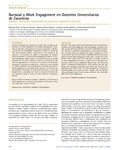
Please use this identifier to cite or link to this item:
http://ricaxcan.uaz.edu.mx/jspui/handle/20.500.11845/572Full metadata record
| DC Field | Value | Language |
|---|---|---|
| dc.contributor | 253332 | es_ES |
| dc.contributor.other | https://orcid.org/0000-0002-7813-2471 | - |
| dc.creator | Ruiz de Chávez Ramírez, Dellanira | - |
| dc.creator | Pando Moreno, Manuel | - |
| dc.creator | Aranda Beltrán, Carolina | - |
| dc.creator | Almeida Perales, Cristina | - |
| dc.date.accessioned | 2018-06-18T19:03:48Z | - |
| dc.date.available | 2018-06-18T19:03:48Z | - |
| dc.date.issued | 2014-08-15 | - |
| dc.identifier | info:eu-repo/semantics/publishedVersion | es_ES |
| dc.identifier.issn | 0718-2449 | es_ES |
| dc.identifier.issn | 0718-0306 | es_ES |
| dc.identifier.uri | http://hdl.handle.net/20.500.11845/572 | - |
| dc.identifier.uri | https://doi.org/10.48779/nmbe-e047 | - |
| dc.description | This study explored the relationship between the Burnout Syndrome and Work Engagement with demographic and labor variables among university academics of Zacatecas. Materials and methods: through a quantitative methodology, an observational analytical, cross-type study was designed by using a sample size of 98 women and 58 men. The instrument of Maslach's Burnout Inventory and the Utrecht Work Engagement Scale with 17 items were used. Results: 62,8% female and 37,2% male had, on average, an age of 44 years. Regarding the Burnout, a high level of exhaustion was observed, where 35,3% of participants had, at least, one dimension burned. A significant relationship (p_ 0,05) between sex, age, and gender with emotional exhaustion was found. The 99,4% of the participants had high levels the Work Engagement. Conclusion: Notwithstanding the constant academic changes, and the physical and psychological strain found among academics, they presented high levels of job engagement. | es_ES |
| dc.description.abstract | El objetivo del estudio fue determinar la relación que existe entre el Síndrome de Burnout y el Work Engagment con variables demográficas y laborales en docentes universitarios de Zacatecas. Fueun estudio de tipo observacional, analítico, transversal en una muestra de 98 mujeres y 58 hombres. Se utilizó el instrumento de Maslach Burnout Inventory y el Utrecht Work Engagement Scale de 17 reactivos. Resultados: 62,8% mujeres y 37,2% hombres con una edad promedio de 43,9 años; respecto al Burnout se evidenció un alto nivel de agotamiento y en el 35,3% con al menos una dimensión quemada. Se encontró una relación (p=0,05) con el sexo, la edad y el grado académico con el agotamiento emocional. En cuanto al Work Engagement se encontraron altos niveles en el 99,4% de los participantes. Conclusión: Lo anterior demuestra que, a pesar del desgaste físico y psicológico en el que se encuentra el docente ante los constantes cambios, cuenta con altos niveles de compromiso laboral. | es_ES |
| dc.language.iso | spa | es_ES |
| dc.publisher | Ciencia y Trabajo | es_ES |
| dc.relation | https://scielo.conicyt.cl/scielo.php?script=sci_abstract&pid=S0718-24492014000200010&lng=es&nrm=iso | es_ES |
| dc.relation.uri | generalPublic | es_ES |
| dc.rights | Atribución-NoComercial-CompartirIgual 3.0 Estados Unidos de América | * |
| dc.rights.uri | http://creativecommons.org/licenses/by-nc-sa/3.0/us/ | * |
| dc.subject.classification | MEDICINA Y CIENCIAS DE LA SALUD [3] | es_ES |
| dc.subject.other | Docentes | es_ES |
| dc.subject.other | Burnout | es_ES |
| dc.subject.other | Engagement | es_ES |
| dc.title | Burnout y Work Engagement en Docentes Universitarios de Zacatecas | es_ES |
| dc.type | info:eu-repo/semantics/article | es_ES |
| Appears in Collections: | *Documentos Académicos*-- M. en C. de la Salud | |
Files in This Item:
| File | Description | Size | Format | |
|---|---|---|---|---|
| Burnout y Work Engagement.pdf | 108,26 kB | Adobe PDF |  View/Open |
This item is licensed under a Creative Commons License
